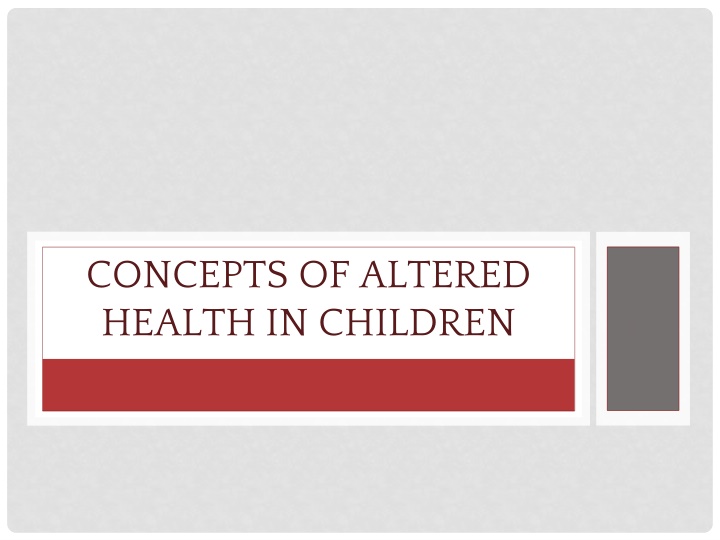
Altered Health in Children and Growth Development Definitions
Explore concepts of altered health in children including growth and development definitions, prenatal period stages, embryonic development, abnormal intrauterine growth, assessment measures for gestation, and Apgar score criteria for infant well-being at birth.
Download Presentation

Please find below an Image/Link to download the presentation.
The content on the website is provided AS IS for your information and personal use only. It may not be sold, licensed, or shared on other websites without obtaining consent from the author. If you encounter any issues during the download, it is possible that the publisher has removed the file from their server.
You are allowed to download the files provided on this website for personal or commercial use, subject to the condition that they are used lawfully. All files are the property of their respective owners.
The content on the website is provided AS IS for your information and personal use only. It may not be sold, licensed, or shared on other websites without obtaining consent from the author.
E N D
Presentation Transcript
CONCEPTS OF ALTERED HEALTH IN CHILDREN
GROWTH AND DEVELOPMENT (DEFINITIONS) Physical Growth Changes in the body as a whole or in its individual parts (percentile) Growth and Development The process whereby a fertilized ovum becomes an adult person Development Embraces aspects of differentiation, such as changes in body function and psychosocial behaviors
THE PRENATAL PERIOD Begins with implantation of the blastocyst The prenatal period is divided into two periods: Embryonic (2nd to 8th week of gestation): formation of germ layers, early tissue differentiation, development of major organs and systems of the body Fetal period (9th week to birth): rapid growth and differentiation of tissues, organs, and body systems
THREE STAGES OF EMBRYONIC DEVELOPMENT First Stage Growth occurs through increase in cell numbers and elaboration of cell products Second Stage Morphogenesis (development of form) occurs, including mass cell movement Third Stage The stage of differentiation or maturation of physiologic processes
ABNORMAL INTRAUTERINE GROWTH Low Birth Weight Infants weighing 2500 g or less at birth Small for Gestational Age (also called intrauterine growth retardation) Birth weight less than two standard deviations below the mean for gestational age or below 10th percentile Large for Gestational Age Birth weight greater than two standard deviations or above 90 percentile
ASSESSMENT MEASURES FOR GESTATION (NOTE THAT INFANTS BORN PRIOR TO 37 WEEKS ARE CONSIDERED PREMATURE) Prenatal Assessment Careful menstrual history, physical milestones during pregnancy, prenatal tests for maturity Postnatal Assessment Examination of external physical and neuromuscular characteristics alone or in combination Ballard method Dubowitz method
CRITERION FOR APGAR SCORE (ASSESSMENT OF INFANT WELL-BEING AT BIRTH) Heart rate Respiratory effort Muscle tone Reflex irritability Color
COMMON HEALTH PROBLEMS OF NEWBORNS Distress at birth and the Apgar score Neonatal hypoglycemia Neonatal jaundice Birth injuries Caput succedaneum Cephalhematoma Brachial plexus injuries Klumpke paralysis Congenital malformations
GROWTH AND DEVELOPMENT Skull development Organ systems continue to grow and mature in an orderly fashion At a minimal level of functioning at birth
SPECIAL NEEDS OF THE PREMATURE INFANT Respiratory problems: Respiratory distress syndrome Apnea and periodic breathing Intraventricular hemorrhage Necrotizing enterocolitis Infection and sepsis
HEALTH PROBLEMS OF THE INFANT Issues related to nutrition Irritable infant syndrome or colic Failure to thrive Sudden infant death syndrome (cause of death is inconclusive) Infectious diseases
FAILURE TO THRIVE Inadequate growth of the child due to the inability to obtain or use essential nutrients Organic Physiologic cause Inorganic Psychological factors
EARLY CHILDHOOD Period from 18 months through 5 years Child passes through two stages: Toddler Preschooler Major achievements are development of locomotion and language Learning is ongoing and progressive
HEALTH RISKS OF EARLY CHILDHOOD Injuries Infectious diseases-Measles, mumps, hepatitis B, and other diseases can be prevented with immunizations Child maltreatment
CHARACTERISTICS OF MIDDLE CHILDHOOD Period occurs from 6 to 12 years Growth averages 3 to 3.5 kg and 6 cm per year Muscular strength, coordination, and stamina increase Ability to perform complex movements increases Can consider several factors simultaneously Can evaluate self and perceive others evaluations
HEALTH RISKS OF MIDDLE CHILDHOOD Respiratory infections Accidents Dental caries Infections involving bacterial and fungal agents Surfacing of acute and chronic problems
ADOLESCENT PERIOD Extends from 13 years through 19 years of age Rapid changes occur in body size and shape and physical and psychological functioning Is a time when hormones and sexual maturation interact with social structures
ADOLESCENT GROWTH AND DEVELOPMENT CNS-mediated hormonal activity Physical growth occurs simultaneously with sexual maturation Growth patterns: Arms, legs, hands, feet, and neck Followed by increases in hip and chest size Several months later by increases in shoulder width and depth and trunk length
ADOLESCENT PERIOD (CONT.) Developmental tasks include Achieving independence from parents Adopting peer codes Making lifestyle choices Forming and adapting to body image
HEALTH RISKS OF ADOLESCENCE Unintentional injuries Vehicle accidents, drowning, falls, firearm mishaps, poisoning, and sports Intentional injuries Homicide and suicide Sexual activity Pregnancy and STDs Substance abuse
